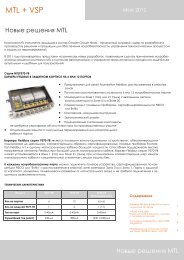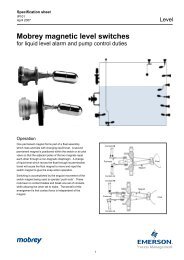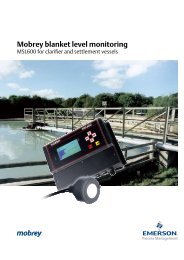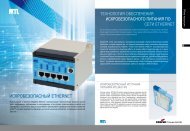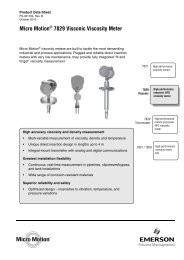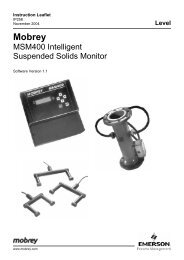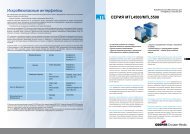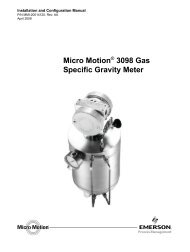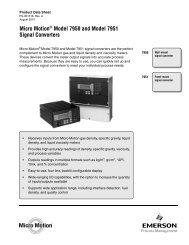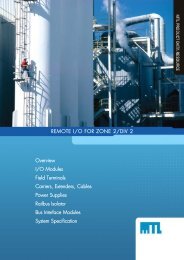Mobrey ultrasonic liquid level detection systems ATEX
Mobrey ultrasonic liquid level detection systems ATEX
Mobrey ultrasonic liquid level detection systems ATEX
Create successful ePaper yourself
Turn your PDF publications into a flip-book with our unique Google optimized e-Paper software.
Interface <strong>detection</strong> and sludge measurementUltrasonic technology can be usedto discriminate between immiscible<strong>liquid</strong>s, to indicate the interface andto detect and monitor suspendedsolids.Interface <strong>detection</strong>For interface <strong>detection</strong> betweenimmiscible <strong>liquid</strong>s, two techniques areavailable: <strong>ultrasonic</strong> attenuation and<strong>ultrasonic</strong> reflection.Both techniques use standard<strong>Mobrey</strong> <strong>liquid</strong> <strong>level</strong> control electronic<strong>systems</strong>. Suitable sensors for interfacemonitoring, are typically the largergap types, that is 150mm upwards.Interface <strong>detection</strong> by attenuationSensor in oilThe <strong>ultrasonic</strong> beam is attenuated and will not reachthe receiver crystalAirOilSensor in waterThe <strong>ultrasonic</strong> beam reaches the receiver crystalOilWaterReceivercrystalTransmittercrystalHeadelectronicsHeadelectronicsUltrasonic attenuation is thereduction in energy of the beam asit is transmitted through the <strong>liquid</strong>.Viscous <strong>liquid</strong>s, emulsions and <strong>liquid</strong>swith entrained solids generally have ahigher <strong>ultrasonic</strong> attenuation than lowviscosity clear <strong>liquid</strong>s such as water.When the attenuation difference issufficient, the amplifier gain can beadjusted so that the ultrasound beampasses through the less attenuative<strong>liquid</strong> but is stopped by the moreattenuative <strong>liquid</strong>. The output relaycan then be set to monitor whichMultipoint & special combination sensorsSpecial sensorsSpecial combinations of sensors areproduced for specific applications- e.g. combined sludge blanketdetectors, pump controls and veryhigh <strong>level</strong> alarms. Such combinationsare designed and engineered for eachindividual application, whether forshipboard high <strong>level</strong> alarms, wasteprocessing plants or reservoir control<strong>systems</strong>. Contact the sales office forfurther information.Multipoint sensorsUltrasonic sensors are easily combinedinto multi-point transducers for two<strong>level</strong> pump control or combined highand low <strong>level</strong> alarms.<strong>liquid</strong> is in the gap.The <strong>ultrasonic</strong> attenuation of a <strong>liquid</strong>depends on many factors, the mainones being the complexity of themolecule, followed by the viscosity,assuming there is no aeration. Many<strong>liquid</strong>s can be distinguished by thistechnique and for further informationon previously tested <strong>liquid</strong> <strong>systems</strong>consult our technical sales. If samplesof the <strong>liquid</strong>s are available then asimple site test can often be done.Interface <strong>detection</strong> by reflectionAirOilWaterAirOilWaterReceivercrystalTransmittercrystalHeadelectronicsHeadelectronicsWhen two immiscible <strong>liquid</strong>s havesimilar attenuations the above methodcannot be used, however it is likelythat the velocity of ultrasound willbe different. In this case a beamof ultrasound passing through theinterface will be reflected andrefracted and if the sensor is arrangedat a shallow angle the effect is thatthe transmitted beam tends to missthe receiver and is thus effectivelyattenuated. An angle of 10 degrees ischosen and often this results in totalinternal reflection of the transmittedbeam. Thus when the interface iswithin the gap of the angled sensor,Typical standard sensors are:Model HD - A two point dual high <strong>level</strong>sensor using two Hi-sens HL sensors.This is typically used for 95% and98% high <strong>level</strong> alarm on marine cargotankers, for outline dimensions seepage 9.Model 373 - A multipoint versionof the 393 sensors, with up to 6switching <strong>level</strong>s.Fitting: ¾" BSPT from inside thevessel. Option: flanged to customerspecificationModel 352 - Two point version of the302 type sensor, fitted from inside oroutside of vesselvery little ultrasound reaches thereceiver, but when the interface isabove or below the sensor (ie in either<strong>liquid</strong>) then there is a large signalpresent. The control unit gain is set toactuate the relay when the interfaceis in the gap. Note this condition willalso occur if the upper <strong>liquid</strong> drainsaway and air (gas) is in the gap. Notefor further information on suitability ofthis application consult our technicalsales.Suspended solids measurementSolids suspended in a <strong>liquid</strong> willscatter <strong>ultrasonic</strong> beams, causingattenuation. This attenuation dependson the size and nature of the particlesand for typical sewage sludges it ispossible to use <strong>Mobrey</strong> <strong>ultrasonic</strong><strong>systems</strong> to detect 1% to 15% w/w.Industrial slurries such as fine potteryslips can often be measured to 65%,but coarse granular material is oftenvery attenuative. Leaflet IP250 givesdetails of <strong>Mobrey</strong> sludge measurement<strong>systems</strong>.Interface and sludge monitoringTypically sensors with gaps of 150mmor larger are used for interface andsludge measurement. These sensorsare standard types 402, 433 and the442 (a pair of sensors for mountingacross or along a pipe section). Specialflanged sensors with the 10 degree tiltbuilt in are also available. Generallythese sensors work at 3.7MHz andare compatible with Electropulse andElectrosensor electronics or plantmounted MCU200 electronics.D C B AMin 27Min 13Max3000BMin 3513¾" BSPTClearance dia. min. 75AMin 37Min 71Max 4553722



